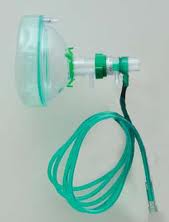Handbook noninvasive ventilation, Anita K. Simonds, ERS
Libro Handbook noninvasive ventilation, Anita K. Simonds, ERS

Hoy voy a compartir con vosotros un libro que he tenido la suerte de comprar en el Congreso Europeo de neumología que se desarrolló en Milán en Septiembre de 2017. Se trata de este manual de Ventilación mecánica no invasiva en el que aborda todos los temas importantes a la hora de comenzar, desarrollar o finalizar la ventilación no invasiva de nuestros pacientes. En este link https://www.ersbookshop.com/ers-practical-handbook-of-noninvasive-ventilation-226-p.asp podéis compralo por 40 euros (30 si sois socios ERS).
Pongo el índice en inglés para que veáis los temas que trata:
Chapter 1 – Introduction
NIV: past, present and future 1 Anita K. Simonds
Chapter 2 – Getting the basics right: equipment
Basic principles of ventilators 10 Alanna Hare and Michelle Chatwin
Matching mode and settings to the patient: an introduction 18 Jan H. Storre and Jens C. Callegari
Choosing the interface 26 Anne-Kathrin Brill
Supplemental oxygen and humidi cation 35 Sundeep Kaul and Anita K. Simonds
Chapter 3 – Getting the basics right: patient selection
The patient with an acute hypercapnic exacerbation of COPD 41 Mark W. Elliott
Patients with acute hypercapnic respiratory failure and 49 neuromuscular or chest wall disease Anita K. Simonds
Patients with acute hypercapnic respiratory failure and OHS 56 Nicholas Hart and Patrick B. Murphy
Patients with acute-on-chronic hypercapnic respiratory failure 60 due to non-COPD obstructive lung disease and interstitial disorders Marieke L. Duiverman and Peter J. Wijkstra
The patient with acute hypoxaemic respiratory failure excluding 67 pulmonary oedema Pongdhep Theerawit, Yuda Sutherasan and Paolo Pelosi
The patient with acute hypoxaemic failure and cardiogenic 72 pulmonary oedema João C. Winck and Luís F. Azevedo
Chapter 4 – Paediatric indications for NIV
Acute NIV in children, including ventilator and interface choice 79 Alessandro Amaddeo and Brigitte Fauroux
Chapter 5 – Airway clearance and physiotherapy
Airway clearance methods and nebulised therapy in acute NIV 86 Michelle Chatwin
Chapter 6 – Monitoring progress in acute NIV
Monitoring choices in acute NIV 93 Raff aele Scala
Starting and stopping acute NIV: when and why? 102 Bernd Schönhofer
Problem-solving: case studies of NIV problems and their 111 management Alanna Hare
Chapter 7 – NIV and the intensive care unit
NIV and weaning 118 Miquel Ferrer
NIV to avoid re-intubation 127 Paolo Navalesi and Federico Longhini
NIV in the perioperative period 135 Yuda Sutherasan, Maria Vargas and Paolo Pelosi
NIV for endoscopic procedures 142 Leo M.A. Heunks, Lisanne Roesthuis and Erik H.F.M. van der Heijden
NIV in respiratory pandemics 148 Anita K. Simonds
Stepping up and down from NIV to tracheostomy ventilation 155 Mark W. Elliott
Chapter 8 – Long-term NIV
Chronic NIV in hereditary neuromuscular disorders 163 Anita K. Simonds
Chronic NIV in motor neurone disease/ALS 176 Joan Escarrabill
Chronic NIV in chest wall disorders 182 Marieke L. Duiverman and Peter J. Wijkstra
Chronic NIV in COPD 190 Wolfram Windisch and Jan H. Storre
Chronic NIV in OHS 197 Patrick B. Murphy and Nicholas Hart
Chronic NIV in bronchiectasis, CF and interstitial lung 204 disease Amanda J. Piper
Patients with acute hypercapnic respiratory failure and OHS 56 Nicholas Hart and Patrick B. Murphy
Patients with acute-on-chronic hypercapnic respiratory failure 60 due to non-COPD obstructive lung disease and interstitial disorders Marieke L. Duiverman and Peter J. Wijkstra
The patient with acute hypoxaemic respiratory failure excluding 67 pulmonary oedema Pongdhep Theerawit, Yuda Sutherasan and Paolo Pelosi
The patient with acute hypoxaemic failure and cardiogenic 72 pulmonary oedema João C. Winck and Luís F. Azevedo
Chapter 4 – Paediatric indications for NIV
Acute NIV in children, including ventilator and interface choice 79 Alessandro Amaddeo and Brigitte Fauroux
Chapter 5 – Airway clearance and physiotherapy
Airway clearance methods and nebulised therapy in acute NIV 86 Michelle Chatwin
Chapter 6 – Monitoring progress in acute NIV
Monitoring choices in acute NIV
93
Ra ff aele Scala
Starting and stopping acute NIV: when and why?
102
Bernd Schönhofer
Problem-solving: case studies of NIV problems and their 111 management Alanna Hare
Chapter 7 – NIV and the intensive care unit
NIV and weaning 118 Miquel Ferrer
NIV to avoid re-intubation 127 Paolo Navalesi and Federico Longhini
NIV in the perioperative period 135 Yuda Sutherasan, Maria Vargas and Paolo Pelosi
NIV for endoscopic procedures 142 Leo M.A. Heunks, Lisanne Roesthuis and Erik H.F.M. van der Heijden
NIV in respiratory pandemics 148 Anita K. Simonds
Stepping up and down from NIV to tracheostomy ventilation 155 Mark W. Elliott
Chapter 8 – Long-term NIV
Chronic NIV in hereditary neuromuscular disorders 163 Anita K. Simonds
Chronic NIV in motor neurone disease/ALS 176 Joan Escarrabill
Chronic NIV in chest wall disorders 182 Marieke L. Duiverman and Peter J. Wijkstra
Chronic NIV in COPD 190 Wolfram Windisch and Jan H. Storre
Chronic NIV in OHS 197 Patrick B. Murphy and Nicholas Hart
Chronic NIV in bronchiectasis, CF and interstitial lung 204 disease Amanda J. Piper
Chronic NIV in heart failure patients: ASV, NIV and CPAP 211 João C. Winck, Marta Drummond, Miguel Gonçalves and Tiago Pinto
Chronic NIV in children: indications, outcomes and transition 217 Hui-Leng Tan and Anita K. Simonds
Practicalities of and guide to cough augmentation and 226 daytime mouthpiece ventilation Michelle Chatwin
Long-term NIV failure: causes and problem solving 234 Jean-Paul Janssens, Dan Adler and Jesus Gonzalez-Bermejo
Long-term NIV case histories 246 Alanna Hare
Chapter 9 – NIV for symptom palliation
NIV in palliative care and at the end of life 253 Anna Maria Cuomo
Chapter 10 – Discharge planning and community care
Discharging the ventilator-dependent adult and child 260 Joan Escarrabill
Home monitoring and follow-up of long-term NIV 265 Dan Adler, Claudio Rabec and Jean-Paul Janssens
Assessing quality of life and outcome of long-term NIV 276 Sophie E. Huttmann and Wolfram Windisch
Patient and carer education, and risk management 282 Joan Escarrabill
Chapter 11 – Setting up an NIV service
Setting up and staffing your NIV unit 289 Joan Escarrabill
Index 295




